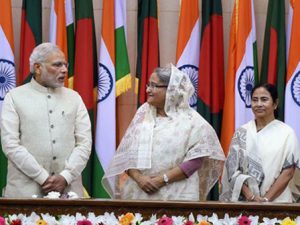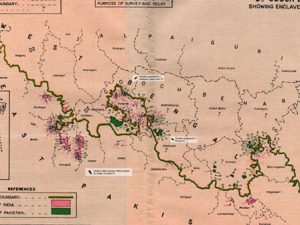People of East: Victims of Cyril Radcliffe’s Pencil
Radcliffe’s demarcation failed to address the concern of villagers who live close to the border. The 1952 agreement between India and Pakistan didn’t consider their concerns either. The people of Chhit Mahals were destined to live as outsiders in their own land.

Chhit Mahals (enclaves) are small pieces of land which belonged to East Pakistan (Now Bangladesh) that remained in India, and vice versa. After the formation of India and Pakistan in 1947, the modern concept of boundary came into existence. Those who for long had the privilege for free movement between Balochistan and Chittagong, thanks to the existence of Akhand Bharat (Greater India), became citizens of two different states overnight since the Islamic Republic of Pakistan was born.
After two decades of formation of India and Pakistan, another nation was born in the east. Bangladesh, a country for Bengali-speaking people, came into being in 1971 after Sheikh Mujibur Rahman led the Mukti Bahini to free the country from Pakistani rule.
Three countries were born in a span of two decades that further added to the complexities of the region, which the people of the subcontinent are yet to recover from. Communal violence, cross-border firing, illegal activities, infiltrations, movement of anti-social elements, smuggling and allegation of killing of Bangladeshi nationals by Border Security Force (BSF) have been rampant. Even the installation of barb wire fencing has failed to restrict these activities in some areas.
The Root of the Problem—Demarcation
The British government which ruled Akhand Bharat for two centuries gave the task of demarcation to Cyril Radcliffe, a British barrister. With no prior knowledge of India and its demography, Radcliffe set foot in the subcontinent for the first time on 8 July 1947, only 37 days before of Pakistan’s independence.
He headed two boundary commissions: one for 4,096 km long line that divided Bengal presidency into two halves another for 553 km long Punjab border in the west. With little time left for site visit and research, Radcliffe ran the pencil through villages, markets, rivers and even through people’s houses. When his job was to provide a solution to the vibrant region of Indian subcontinent comprised of different communities and religions, his work left many baffled and failed to satisfy the boundary commission representatives of the Indian National Congress and Muslim League.
Also Read : Pakistan Quit Balochistan
‘Sometimes those assigned to run the pencil do so, without realising the impact that their line is going to have on humankind. Sir Cyril Radcliffe was one of them’, wrote Bishwanath Ghosh in Gazing at Neighbours: Travels Along the Line That Partitioned India.
Enhancing the complexities further Radcliffe’s demarcations had led to violence, communal dispute, war and conflict in Bengal and Punjab that millions of people were killed in nasty bloodshed. 73 years after India and Pakistan’s freedom from the British rule and 44 years after Bangladesh’s liberation from Pakistani rule, the dispute still has no stoppage. Remember the 2007 diplomatic tension between ruling Indian National Congress and Bangladesh Nationalist Party regarding the establishment of Tin Bigha corridor, a strip of land on West Bengal–Bangladesh border that India leased to Bangladesh in 2015 so the country could access its Dahagram–Angarpota enclave from the mainland.
Land Boundary Agreement
While the border dispute in Kashmir has continued to be the biggest threat to the regional peace, Indian and Bangladeshi leaders signed Land Boundary Agreement (LBA) in 2015 to bring an end to the plight of Chhit Mahal dwellers.
Radcliff’s demarcation failed to address the concern of villagers who live close to the border. The 1952 agreement between India and Pakistan didn’t consider their concerns either. With cross-border illegal activities on the rise, India and Pakistan introduced the passport and visa system in order to regulate the eastern border.

For the people of Chhit Mahals, the situation had become more complex since they were outsiders in their own land. As their localities fell in no man’s land, they literally became stateless people but not refugees. Since there was no mention of them in the agreement, they had no idea of belonging to a state. With no voting rights, no school, no hospital or Public Distribution System (PDS), they were unaware of the meaning of belonging to a nation.
However, to ‘mitigate the hardships that the residents of the enclaves have had to endure’; Bangladesh and India had signed LBA in 1974 for the first time. As opposition leaders of either country vehemently opposed the idea of swapping Chhit Mahal with each other, the agreement took another three decades to become a reality.
In 2015, Indian Prime Minister Narendra Modi and his Bangladeshi counterpart Sheikh Hasina have finally resolved the issue andsigned the agreement in the presence of West Bengal Chief Minister Mamata Banerjee. The LBA was passed in the parliament. As per the agreement, India transferred 111 Chhit Mahals to Bangladesh, while Bangladesh transferred 51 pieces of lands to India.
The agreement also allowed the people of these enclaves to decide which country they wanted to join. They got voting rights and have access to all the facilities a government provides to its citizen—a new experience to the people of the ‘stateless’.
Also Read : Us Lawmakers Criticism Over Human Rights Violations In Kashmir
Chhit Mahal residents have officially become citizens of India and Bangladesh and barb wire fencing has been installed to reduce cross-border crimes. But their identity has never changed.
They are still being called Chhit Mahal dwellers, a social stigma that has become a part of their daily life.
Radcliff might have burned demarcation papers and refused to collect his fee of INR 40,000, but the pain his flawed work caused to the people of enclaves in the East is still making them suffer even 73 years after the partition.
Writing in the Economic and Political Weekly, Sumanta Banerjee rightly termed Radcliffe’s partition a ‘sloppy surgery’, while Bishwanath Ghosh called it ‘The Surgical Scars’, that continue to haunt people of the east.
Jump-cut to 2020, as much debated Citizenship Amendment Act (CAA) that will be followed by National Register of Citizens (NRC) are set to come into force, people of Chhit Mahals could once again find them in hot water as they lack documents to meet the criterion set by the Indian government to be citizens. It will not be an exaggeration to say that Radcliffe’s 73 years old blunder could once again make them bear the brunt.
